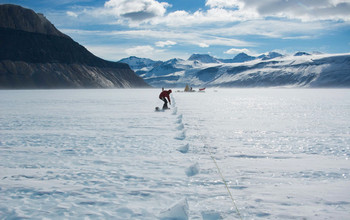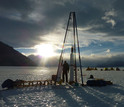News Release 14-058
Krypton-dating technique allows researchers to accurately date ancient Antarctic ice
NSF-funded technique may eventually allow scientists to better understand cycles of ice ages

Field glaciologist Daniel Baggenstos samples on the Taylor Glacier in Antarctica.
April 21, 2014
This material is available primarily for archival purposes. Telephone numbers or other contact information may be out of date; please see current contact information at media contacts.
A team of scientists, funded by the National Science Foundation (NSF), has successfully used a new technique to confirm the age of a 120,000-year-old sample of Antarctic ice.
The new dating system is expected to allow scientists to identify ice that is much older, thereby reconstructing climate much farther back into Earth's history and potentially leading to an understanding of the mechanisms that cause the planet to shift into and out of ice ages.
The use of a radiometric-Krypton-dating technique on ice from Antarctica's Taylor Glacier was documented in a paper published this week in the Proceedings of the National Academy of Sciences (PNAS).
The new technique provides an accurate means of confirming the age of ice samples, and researchers note it is now the most precise dating tool for ancient ice.
"The oldest ice found in drilled cores is around 800,000 years old and with this new technique we think we can look in other regions and successfully date polar ice back as far as 1.5 million years," said Christo Buizert, a postdoctoral researcher at Oregon State University and lead author on the PNAS article. "That is very exciting because a lot of interesting things happened with the Earth's climate prior to 800,000 years ago that we currently cannot study in the ice-core record."
The work was supported by two collaborative awards 0838936 and 0839031 made by the Division of Polar Programs in NSF's Geosciences Directorate and by the U.S. Department of Energy. Through Polar Programs, NSF manages the United States Antarctic Program, which coordinates all U.S. research on the southernmost continent and the logistical support for the science.
Buizert, whose work also was supported in part by the National Oceanic and Atmospheric Administration, said reconstructing the Earth's climate back to 1.5 million years is important because a shift in the frequency of ice ages took place in what is known as the Middle Pleistocene transition. The Earth is thought to have shifted in and out of ice ages every 100,000 years or so during the past 800,000 years, but there is evidence that such a shift took place every 40,000 years prior to that time.
"Why was there a transition from a 40,000-year cycle to a 100,000-year cycle?" asked Buizert. "Some people believe a change in the level of atmospheric carbon dioxide may have played a role. That is one reason we are so anxious to find ice that will take us back further in time so we can further extend data on past carbon dioxide levels and test this hypothesis."
Krypton dating is much like the more-heralded carbon-14 dating technique that measures the decay of a radioactive isotope--which has constant and well-known decay rates--and compares it to a stable isotope. Unlike carbon-14, however, Krypton is a Noble gas that does not interact chemically and is much more stable with a half-life of around 230,000 years, Buizert pointed out. Carbon dating doesn't work well on ice because carbon-14 is produced in the ice itself by cosmic rays.
Krypton is produced by cosmic rays bombarding the Earth and then stored in air bubbles trapped within Antarctic ice. It has a radioactive isotope (Krypton-81) that decays very slowly, and a stable isotope (Krypton-83) that does not decay. Comparing the proportion of stable-to-radioactive isotopes provides the age of the ice.
Though scientists have been interested in radiokrypton dating for more than four decades, Krypton-81 atoms are so few and so difficult to count that it wasn't until a 2011 breakthrough in detector technology that Krypton-81 dating could be made available to earth science communities at large. The new atom counter, named Atom Trap Trace Analysis, or ATTA, was developed by a team of nuclear physicists led by Zheng-Tian Lu at Argonne National Laboratory near Chicago.
Development of the ATTA-3 instrument was funded, in part, by the Division of Earth Sciences in NSF's Geosciences Directorate.
In their experiment at Taylor Glacier in Antarctica, the researchers put several 300-kilogram (about 660 pounds) chunks of ice into a container and melted it to release the air from the bubbles, which was then stored in flasks. A newly developed, Blue Ice Drill, which has a diameter of 24.1 centimeters (9.5 inches) was used to obtain the samples. The drill development was funded through a collaborative award to the University of California, San Diego, a sub-award to the University of Wisconsin. The work was funded under the American Recovery and Reinvestment Act of 2009.
The Krypton was isolated from the air and sent to Argonne National Laboratory near Chicago. Argonne researchers led by Zheng-Tian Lu, a co-author on the PNAS paper, first used Krypton dating a decade ago on very old groundwater and since have refined the techniques using what they call the Atom Trap Trace Analysis method, or ATTA.
"The atom trap is so sensitive that it can capture and count individual atoms and Argonne currently has the only instrument in the world with that capability," said Buizert, of Oregon State's College of Earth, Ocean, and Atmospheric Sciences. "The only problem is that there isn't a lot of Krypton in the air, and thus there isn't much in the ice, either. That's why we need such large samples to melt down."
Meanwhile, the group at Argonne is continually improving the ATTA detector. "We can perform Krypton-81 dating on an ice sample of 40-80 kilograms," said Lu. "Within a year, we aim to perform analysis on an ice sample as small as 20 kilograms."The researchers determined from the isotope ratio that the Taylor Glacier samples were 120,000 years old and validated the estimate by comparing the results to well-dated ice core measurements of atmospheric methane and oxygen from that same period.
Now the challenge is to locate some of the oldest ice in Antarctica, which may not be as easy as it sounds, the researchers say.
"Most people assume that it's a question of just drilling deeper for ice cores, but it's not that simple," said Edward Brook, an Oregon State University geologist and co-author on the study. "Very old ice probably exists in small isolated patches at the base of the ice sheet that have not yet been identified, but in many places it has probably melted and flowed out into the ocean."
There also are special regions where old ice is exposed at the edges of an ice field, Brook pointed out.
"The international scientific community is really interested in exploring for old ice in both types of places and this new dating will really help," Brook said. "There are places where meteorites originating from Mars have been pushed out by glaciers and collect at the margins. Some have been on Earth for a million years or more, so the ice in these spots may be that old as well."
-NSF-
-
Ice core driller Tanner Kuhl with the blue-ice drill on Taylor Glacier in Antarctica.
Credit and Larger Version
Media Contacts
Peter West, NSF, (703) 292-7530, email: pwest@nsf.gov
Mark Floyd, Oregon State University, (541) 737-0788, email: mark.floyd@oregonstate.edu
Principal Investigators
Ed Brook, Oregon State University, (541) 737-8197, email: brooke@geo.oregonstate.edu
Christo Buizert, Oregon State University, (541) 737-1209, email: buizertc@science.oregonstate.edu
The U.S. National Science Foundation propels the nation forward by advancing fundamental research in all fields of science and engineering. NSF supports research and people by providing facilities, instruments and funding to support their ingenuity and sustain the U.S. as a global leader in research and innovation. With a fiscal year 2023 budget of $9.5 billion, NSF funds reach all 50 states through grants to nearly 2,000 colleges, universities and institutions. Each year, NSF receives more than 40,000 competitive proposals and makes about 11,000 new awards. Those awards include support for cooperative research with industry, Arctic and Antarctic research and operations, and U.S. participation in international scientific efforts.
Connect with us online
NSF website: nsf.gov
NSF News: nsf.gov/news
For News Media: nsf.gov/news/newsroom
Statistics: nsf.gov/statistics/
Awards database: nsf.gov/awardsearch/
Follow us on social
Twitter: twitter.com/NSF
Facebook: facebook.com/US.NSF
Instagram: instagram.com/nsfgov



